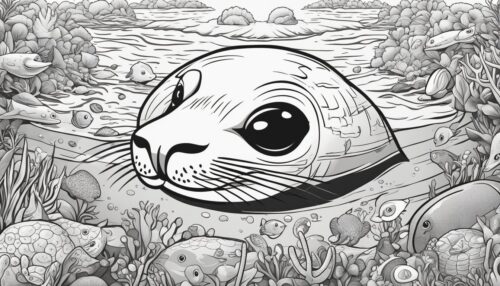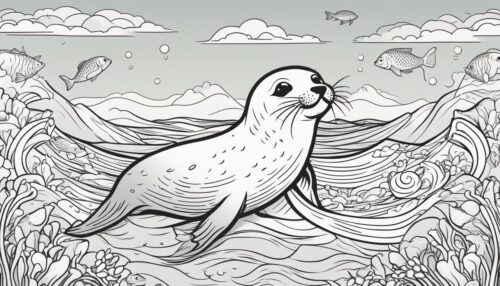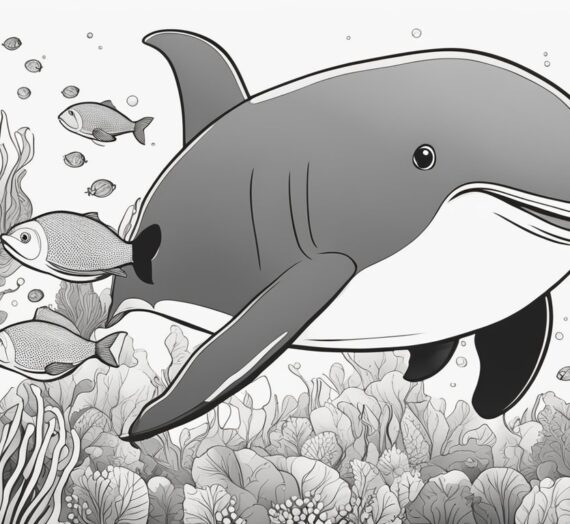Seal Coloring Page: Fun and Easy Activity for Kids. Seal coloring pages are a fun and educational activity for children of all ages. These pages feature different species of seals in various settings, including the ocean, snow, and even mandalas. Coloring can help improve a child’s fine motor skills, hand-eye coordination, and creativity, making it a valuable pastime.
Seal Coloring Page



Not only are seal coloring pages enjoyable, but they also provide an opportunity to learn about these fascinating creatures. Children can learn about the different types of seals, their habitats, and behaviors while coloring. This can spark an interest in marine life and conservation efforts, encouraging children to become more aware of the environment and its inhabitants.
There are many free seal coloring pages available online, making it easy and accessible for parents and educators to incorporate this activity into their curriculum or leisure time. With a wide variety of designs and levels of complexity, there is a seal coloring page for every child to enjoy.
The Importance of Seal Coloring Pages




Seal coloring pages are not just a fun activity for children, but they also have several educational benefits. Coloring pages can help children learn about different species of seals, their habitats, and behavior.
Educational Benefits
Seal coloring pages can be used as a tool to teach children about the environment and conservation. By coloring pictures of seals, children can learn about the importance of protecting marine life and preserving their habitats. This can help create awareness and promote responsible behavior towards the environment.
Development of Motor Skills
Coloring pages can also help in the development of motor skills in young children. Holding and manipulating a crayon or a colored pencil can help improve their hand-eye coordination and fine motor skills. This can also help in developing their writing skills and prepare them for school.
Creativity and Expression
Coloring pages can provide an outlet for children to express their creativity and imagination. By coloring different patterns and designs, children can experiment with different colors and learn about color combinations. This can also help in developing their artistic skills and boost their confidence.
In conclusion, seal coloring pages are a fun and educational activity for children that can help in their overall development. They can learn about the environment, develop their motor skills, and express their creativity through coloring. Best Tours from Rome to Pompeii
Types of Seal Coloring Pages



Cartoon Seal Illustrations
Cartoon seal illustrations are popular among children due to their fun and playful nature. These illustrations typically feature seals in various poses and expressions, often with exaggerated features such as big eyes and chubby bodies. They are great for encouraging creativity and imagination in young children, and can be used to teach them about different emotions and expressions.
Realistic Seal Depictions
Realistic seal depictions are perfect for older children and adults who want a more detailed and accurate representation of seals. These coloring pages often feature seals in their natural habitat, with intricate details such as fur texture and shading. They are great for teaching children about the anatomy and biology of seals, and can be used to inspire a love for marine life and conservation.
Seals in Their Natural Habitat
Seals in their natural habitat coloring pages are a great way to teach children about different environments and ecosystems. These coloring pages feature seals in their natural habitats, such as on the beach or in the ocean. They can be used to teach children about the importance of protecting the environment and the animals that live in it. Additionally, they can be used to teach children about different ocean creatures and how they interact with each other.
In conclusion, seal coloring pages are a great way to encourage creativity, teach children about marine life and conservation, and inspire a love for the environment. Whether you prefer cartoon illustrations or realistic depictions, there is a seal coloring page for everyone.
Choosing the Right Materials


Paper Types
When it comes to coloring pages, choosing the right paper is key to achieving the desired results. The ideal paper should be thick enough to withstand the pressure applied by coloring tools without tearing or bleeding through to the other side.
Cardstock or heavyweight paper is a great option for seal coloring pages. These papers are thicker and sturdier than regular printer paper, and they can handle a variety of coloring tools, including markers, colored pencils, and crayons.
For those who prefer a smoother surface, Bristol paper is an excellent choice. It has a smooth texture that allows coloring tools to glide easily across the surface, resulting in clean, crisp lines and vibrant colors.
Coloring Tools
Choosing the right coloring tools is just as important as selecting the right paper. Different coloring tools produce different effects, so it’s essential to choose the ones that best suit your preferences and skill level.
Colored pencils are a popular choice for seal coloring pages. They allow for precise control and shading, making them perfect for adding depth and dimension to your artwork.
Markers are another option for those who prefer bold, vibrant colors. They come in a variety of tip sizes and shapes, allowing for a range of line widths and textures.
Crayons are a classic coloring tool that is easy to use and perfect for beginners. They come in a wide range of colors and are ideal for large areas of coloring.
No matter which coloring tool you choose, it’s essential to test them on a small area of the paper first to ensure that they don’t bleed through or damage the paper. With the right paper and coloring tools, you can create beautiful and vibrant seal coloring pages that you’ll be proud to display.
Step-by-Step Coloring Guide



Understanding Color Theory
Before starting to color, it’s important to understand the basics of color theory. This will help in choosing the right colors and creating a visually appealing coloring page. The primary colors are red, blue, and yellow. Secondary colors are created by mixing two primary colors together. For example, blue and yellow make green. Tertiary colors are created by mixing a primary color with a secondary color.
Techniques for Shading
Shading is an important technique to give depth and dimension to a coloring page. The most common shading technique is to use different shades of the same color. For example, using light blue for the lighter areas and dark blue for the darker areas. Another technique is to use complementary colors, which are opposite each other on the color wheel. This creates contrast and makes the colors stand out.
Finishing Touches
Once the coloring is complete, there are a few finishing touches that can be added to make the page stand out. Adding highlights with a white or light-colored pencil can create a shiny or glossy effect. Using a black or dark-colored pencil to outline the edges of the page can create a border and make the colors pop. Adding texture with cross-hatching or stippling can create a more realistic effect.
Overall, coloring can be a fun and relaxing activity for all ages. By understanding color theory, using shading techniques, and adding finishing touches, anyone can create a beautiful and unique coloring page.
Seal Species and Characteristics


Common Seal Species
There are 33 known species of seals, and they are divided into three families: Phocidae (true seals), Otariidae (eared seals), and Odobenidae (walruses). The most common species of seals are the harbor seal, gray seal, and ringed seal.
The harbor seal is found along the coasts of the North Atlantic and Pacific Oceans. They are known for their spotted coat and can grow up to six feet in length. The gray seal is found in the North Atlantic and can grow up to ten feet in length. They are known for their gray coat and distinctive horse-like face. The ringed seal is found in the Arctic and sub-Arctic regions and is the smallest of the seal species, growing up to five feet in length.
Physical Features
Seals are marine mammals and are well adapted to living in the water. They have a streamlined body shape, which helps them swim quickly and efficiently. Their flippers are short and powerful, and they use them to steer and brake while swimming. Seals are covered in a thick layer of blubber, which helps keep them warm in cold water and provides buoyancy.
Seals have several physical features that help them survive in their environment. They have large eyes that allow them to see well in low light conditions, and their nostrils can close tightly to prevent water from entering their lungs. Seals also have sensitive whiskers that help them detect prey in the water.
Habitat and Behavior
Seals are found in both the Arctic and Antarctic regions, as well as in temperate and tropical waters. They are social animals and can be found in groups of varying sizes. Seals are carnivorous and feed on a variety of fish, squid, and crustaceans.
Seals spend much of their time in the water, but they also come ashore to rest, mate, and give birth. They are able to hold their breath for long periods of time and can dive to great depths in search of food. Seals are also known for their vocalizations, which they use to communicate with each other both in and out of the water.
Printable vs. Online Coloring Pages


When it comes to choosing between printable and online coloring pages, there are pros and cons to both options. In this section, we will explore the benefits of each type of coloring page.
Benefits of Printable Pages
Printable coloring pages offer a number of advantages over online coloring pages. First and foremost, printable pages do not require an internet connection to use. This means that children can color whenever and wherever they want, without needing to be near a computer or tablet.
Printable pages are also more versatile than online pages. Children can use a variety of coloring materials, such as markers, crayons, or colored pencils, to color printable pages. This allows them to experiment with different textures and techniques, and can help to develop their fine motor skills.
Another benefit of printable pages is that they can be easily shared. Parents or teachers can print out multiple copies of a page, allowing multiple children to color the same design. This can be particularly useful in group settings, such as classrooms or playdates.
Interactive Online Platforms
Online coloring pages, on the other hand, offer a different set of benefits. One of the primary advantages of online coloring pages is that they are interactive. Many online coloring platforms include tools that allow children to change the color of their digital crayons or markers, undo mistakes, or even add special effects to their coloring pages.
Online coloring pages can also be more engaging than printable pages. Many online platforms offer a wide variety of designs, including popular cartoon characters, animals, and nature scenes. This can help to keep children interested and motivated to color.
Another advantage of online coloring pages is that they can be accessed from anywhere with an internet connection. This means that children can color on a computer, tablet, or even a smartphone, making it easy to fit coloring into their daily routine.
In conclusion, both printable and online coloring pages have their own unique advantages. Parents and educators should consider the needs and preferences of their children when choosing between the two options. Ultimately, the most important thing is to provide children with opportunities to express their creativity and have fun while doing so.
Incorporating Seal Facts into Coloring Sessions
Educational Captions
Adding educational captions to coloring pages can help children learn about seals while having fun. For example, a caption can explain that seals are marine mammals that spend most of their time in the water and come to land to rest and give birth. Another caption can describe the different types of seals, such as harbor seals, elephant seals, and leopard seals, and their unique features.
Children can also learn about the diet of seals through captions. Seals eat fish, squid, and other marine animals, and they have special adaptations, such as sharp teeth and streamlined bodies, to help them catch their prey. Captions can also highlight the threats that seals face, such as pollution, overfishing, and climate change, and the importance of protecting them and their habitats.
Discussion Topics
Coloring sessions can also be an opportunity for discussion and exploration of seal facts. Parents or educators can ask children questions such as “What do you think seals eat?” or “Why do you think seals need to come to land?” and encourage them to think critically and creatively.
Children can also be encouraged to research and share their own seal facts. They can use books, websites, or other resources to learn about seals and their habitats, and then share their findings with others. This can help children develop research skills, expand their knowledge, and foster a love of learning.
Incorporating seal facts into coloring sessions can be a fun and educational way to engage children and help them learn about these fascinating marine mammals. By adding educational captions and encouraging discussion and exploration, children can develop a deeper understanding and appreciation of seals and their importance in our world.
Seal Conservation and Awareness
Threats to Seal Populations
Seals are facing a number of threats to their survival, including climate change, habitat loss, pollution, and overfishing. The Arctic and sub-Arctic regions are particularly vulnerable, as the melting of sea ice is reducing the seals’ access to food and breeding grounds. Pollution, such as oil spills and plastic waste, can also harm seals by contaminating their food sources and damaging their habitats.
Overfishing is another major threat to seal populations, as it can reduce the availability of fish and other prey that seals rely on for survival. This can have a ripple effect throughout the ecosystem, as seals play an important role in maintaining the balance of marine food webs.
Conservation Efforts
To help protect seal populations, a number of conservation efforts are underway around the world. These include measures to reduce pollution, protect habitats, and regulate fishing practices. For example, some countries have established marine protected areas where seals and other marine life are given greater protection from human activities.
In addition, many organizations are working to raise awareness about the importance of seal conservation and the threats facing these animals. This includes educational programs for schools and communities, as well as advocacy efforts to promote policies and regulations that support seal conservation.
Overall, while the threats facing seal populations are significant, there is hope that with continued conservation efforts, these animals can be protected for future generations to enjoy.
Resources and References
Books and Publications
There are many books and publications available on the topic of seal coloring pages. One such book is “Seal Coloring Book for Kids” by Coloring Pages for Kids. This book includes a variety of seal coloring pages, from cute and cartoonish to realistic and detailed. It is designed for children aged 4-8 and provides a fun and educational way for kids to learn about seals and their habitats.
Another publication worth mentioning is “Seals of the World” by Nigel Bonner. This book provides detailed information about different species of seals, including their physical characteristics, behavior, and habitat. While it is not specifically a coloring book, it can be a useful reference for those interested in creating accurate and realistic seal coloring pages.
Websites and Online Resources
The internet is a great resource for finding free seal coloring pages. One website that offers a variety of options is Supercoloring.com. This website provides a range of seal coloring pages, from simple and easy to color to more complex and detailed designs. In addition to seals, the website also offers coloring pages of other marine animals, such as dolphins and whales.
Another online resource worth checking out is mondaymandala.com. This website offers 20 free seal coloring pages, featuring a range of designs from cute and cartoonish to intricate mandalas. The website also offers tips and techniques for coloring, making it a great resource for beginners and experienced colorists alike.
Overall, there are many resources available for those interested in creating seal coloring pages. Whether you prefer books, websites, or a combination of both, there is no shortage of inspiration and information to help you create beautiful and accurate seal coloring pages.



